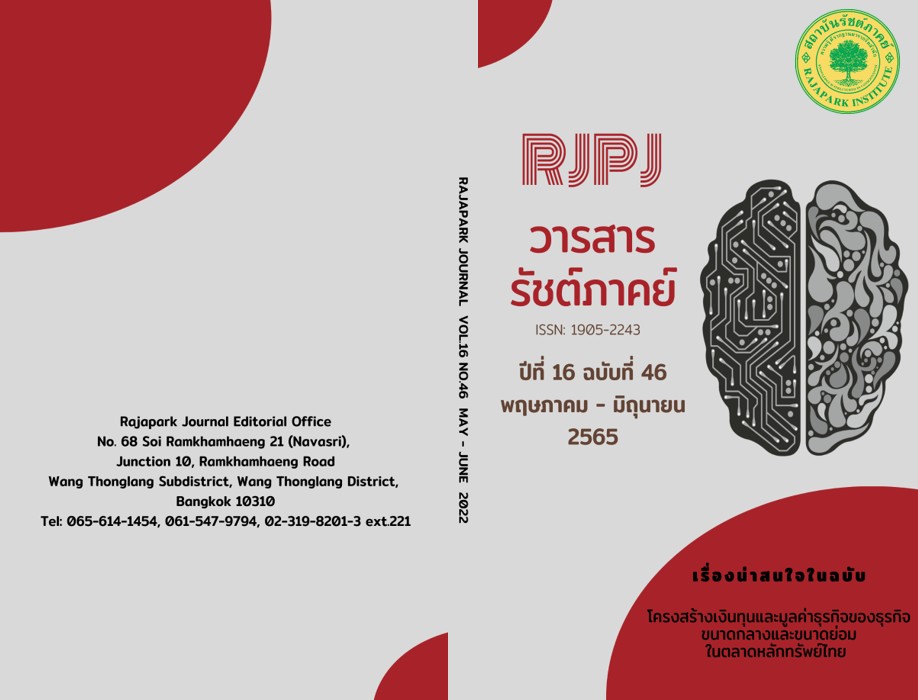Avitourism: A Special-interest Tourism which should be Promoted in Thailand
Main Article Content
Abstract
This article aims to analyze why Thailand is suitable for avid tourism and how to actively encourage avitourism in Thailand. The scope of the presentation is defined as follows: (1) The meaning of avitourism which refers to traveling from a normal environment with the main aim of studying and enjoying the nature by searching, observing, classifying, and listening to the sounds of birds in natural habitats while disturbing the environment and natural scenery as little as possible. (2) Grouping the avitourism which is divided into 3 groups (3) Avitourism and tourism sustainability which this type of tourism can contribute the sustainability as well. (4) The characteristics of the area where avid tourists choose to watch the birds which have 4 characteristics. (5) So is "Thailand" worth an avitourism trip? Thailand is characterized by bird-watching areas that avid tourists prefer to visit, along with the potential for tourism accommodations. Therefore, Thailand is very suitable for avitourism. However, the development of avitourism in Thailand is not very clear, it should be promoted in many ways, such as conducting the studies to find all-around information related to avitourism for planning to promote this type of special interest tourism, etc.
Article Details

This work is licensed under a Creative Commons Attribution-NonCommercial-NoDerivatives 4.0 International License.
Views and opinions appearing in the Journal it is the responsibility of the author of the article, and does not constitute the view and responsibility of the editorial team.
References
Bird Conservation Society of Thailand. (2016). Report of Water Birds Counting in the Winter of Asia 2016. n.p.
Bird Conservation Society of Thailand. (2020). Checklist_ThaiBirds_2020 ver. September 2020. https://www.bcst.or.th/report-archives/
Bird Life International. (2021a). 11 Spectacular Bird Migration Bottlenecks from Around the World. http://www.birdlife.org/worldwide/news/11-spectacular-bird-migration-bottlenecks-around-world?qt-read_more_news_tab=0
Bird Life International. (2021b). Country Profile: Indonesia, China and Myanmar. http://datazone.birdlife.org/country/
Bird Life International. (2021c). Migratory Birds & Flyways. https://www.birdlife.org/worldwide/programmes/migratory-birds
CBI. (2021a). Entering the European Market for Bird Watching Tourism Products. https://www.cbi.eu/market-information/tourism/bird-watching/market-entry
CBI. (2021b). The European Market Potential for Birdwatching Tourism. https://www.cbi.eu/market-information/tourism/birdwatching-tourism/market-potential
CBI. (2021c). The European Market Potential for Wildlife Tourism. https://www.cbi.eu/market-information/tourism/wildlife-tourism/market-potential
Center for Responsible Travel. (n.d.). Market Analysis of Bird-based Tourism: A Focus on the U.S. Market to Latin America and the Caribbean Including Fact Sheets on the Bahamas, Belize, Guatemala, Paraguay. https://30ghywahyur3pzyoi3qg4r9c-wpengine.netdna-ssl.com/wp-content/uploads/sites/213/2021/03/market-analysis-bird-based-tourism.pdf
Community Homestay Network. (2022). Bird-watching in the Community Forest-Watch and Listen to the Birds of Bardiya. https://www.communityhomestay.com/experiences/bird-watching-55
Conradie, N. (2017). A Literacy Model for Sustainable Avitourism[Doctoral dissertation, University of South Africa].
Department of Tourism. (2021).The Standard of Bird Watching Activity. https://www.dot.go.th/ebooks/ebooks-view/414
Hungarianbirdwatching.com. (n.d.). Birdwatching Ethics. https://www.hungarianbirdwatching.com/02_Ethics.html#ResponsibleTourism
Krejić, Z.R., Milićević, S., Plećić, K., & Babić, Dragana. (2019). The Possibility of the Development of Bird Watching as a Specific Form of Tourism in the Deliblato Sands-Case Study. TEME, Journal for Social Sciences, 43(2), 475-488. https://doi.org/10.22190/TEME180305029K
Priatmoko, S., & David, L.D. (2020). Avitouriam to Fight Climate Change: A Proposal for Mother Earth. In Proceeding of The 20th International Scientific Conference on Management of Environment 2020, June 25, (pp.138-147). Bratislava, Slovakia.
Ritchie, H., & Roser, M. (2021). Biodiversity “Birds”. https://ourworldindata.org/birds
Statista. (2021). Number of participants in birdwatching in the United States from 2006 to 2019. https://www.statista.com/statistics/191207/participants-in-birdwatching-in-the-us-since-2006/
Steven, R., Morrison, C., & Castley, J.G. (2014). Birdwatching and Avitourism: A Global Review of Research Into Its Participant Market, Distribution and Impacts, Highlighting Future Research Priorities to Inform Sustainable Avitourism Management. Journal of Sustainable Tourism, 23(8-9), 1257-1276. https://doi.org/10.1080/09669582.2014.924955
Suksatit, K. (2008). The Problem and Application of Bird Watching Activity’s Standard[Independent Study, Master of Science, National Institute of Development Administration].
Tourism Authority of Thailand. (n.d.). 20 Bird-watching Sites in Thailand. n.p.
Tustin, D.H., & Conradie, N. (2016). Benchmarking Avi-tourism Literacy Rates among Gauteng School Learners. South African Journal of Business Management, 47(3), 55-61. https://doi.org/10.4102/sajbm.v47i3.68
U.S. Fish & Wildlife Service. (2019). Birding in the United State: A Demographic and Economic Analysis. U.S. Fish & Wildlife Service.
Withrow, B. (2019). Birding (Yes, Birding) Is a Multi-Billion Dollar Ecotourism Industry. https://www.thedailybeast.com/birding-yes-birding-is-a-multi- billion-dollar-ecotourism-industry?ref=scroll


